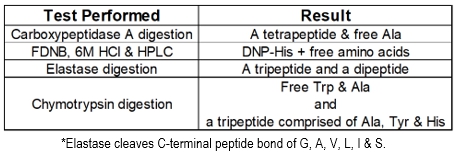In this video, we're going to begin our discussion on peptidases. So by now, you guys have probably picked up that peptidases are just enzymes, and we know that because it ends in "ase." And anything that ends in "ase" is a good indicator that it's probably an enzyme. Peptidases are indeed enzymes that selectively catalyze the hydrolysis of very specific peptide bonds. And really that's just a fancy way of saying that peptidases are enzymes that cleave or break down very specific peptide bonds. We know this from our previous lessons, where we learned that hydrolysis is just a process of breaking down peptides. Some of these peptidases include trypsin and chymotrypsin, both of which are biologically relevant to our digestive systems. They help us break down proteins found in foods into smaller peptide fragments that our cells can use.
Moving forward, we're first going to focus on trypsin, and then in a different video, we'll focus on chymotrypsin. Trypsin is one of the more specific peptidases because it only cleaves peptide bonds on the carboxyl side of both lysine and arginine amino acid residues. Recall that lysine's one-letter code is K and arginine's one-letter code is R. This specificity is exactly what we mean in our definition of peptidases. So, peptidases don't just cleave random peptide bonds; they cleave very specific peptide bonds next to very specific amino acid residues.
There's something very important you should note before we get to our example. The cleavage of a peptide bond by a peptidase can be blocked or inhibited if a proline amino acid residue is involved in the peptide bond. If a proline residue is involved, it's likely that the peptide bond will not be cleaved because it will be blocked or inhibited from being cleaved. We'll see an example of this below. In our example, we ask where trypsin will do its peptide bond splitting, not in formal terms but as a way to remember easier, comparing the action of trypsin to a knight's sword, specifically after lysine and arginine.
Let's discuss the mnemonic that helps us remember these amino acids: "dragons eat knights riding horses," where K represents lysine and R represents arginine. Lysine's R group resembles a knight's sword, extended and pointy. It has 4 carbon atoms leading to an amino group at the end of its chain. Arginine, on the other hand, has a chain starting with 3 carbon atoms and ends with a triangular nitrogen, resembling a knight's sword. These features are ideal for splitting things, much like a knight's sword splits a watermelon in half. This is how trypsin cleavage is modeled.
In our tetrapeptide example, with four amino acid residues and an N-terminal with a free amino group and a C-terminal with a free carboxylate group, trypsin will cleave after the lysine and arginine residues. However, there’s a proline residue involved in one of the supposed cleavage sites, and this peptide bond will be blocked and inhibited from being cleaved. Only the bond shown in red will actually be cleaved. This results in an alanine-lysine fragment on one side and an arginine-proline fragment on the other.
In our next video, we'll get more practice with trypsin and the cleavage of peptides and proteins. I'll see you guys in that video.





